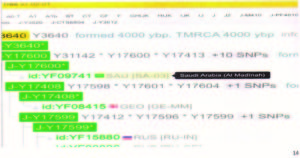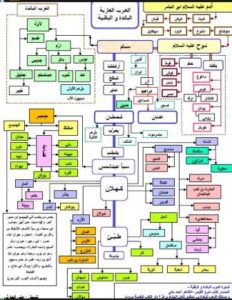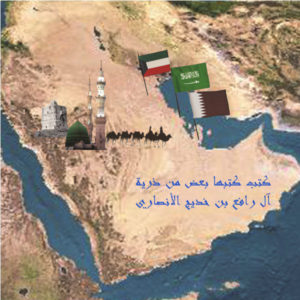Chapter II
Alnsari family lineage and emigration
From historical references, manuscripts, and documents
The lineage of the Al-Ansari family and their migration:
In: Kuwait, Saudi Arabia, and Qatar
Friday search and books
MR. Khaled Salem Mohammed bin Abdullah Al-Ansari
(The title of our ancestors was the supporters, and our lineage ends (for Rafi bin Khadeej Al-Awsi) according to what my grandfather Mulla Muhammad affirmed to my father, and it was documented and what I found also from the documents of Uncle Mulla Yassin – may God have mercy on them – and the family’s ancient origins lived in a village near the Prophet City ([2]) It is called (Orwa), and – it is said that some families of the descendants of the Ansar are still residing there – and our original lineage according to what was attributed to them belongs to the great companion: Rafeh bin Khadeej Al-Ansari Al-Harthy, who is an Ansari from the Aws, who witnessed my conquest: one of the ditches “parties”, It was narrated from him that they combined the hadiths of the Prophet, may God’s prayers and peace be upon him, hadiths raised to the Prophet – may God’s prayers and peace be upon him – including them Larry and Muslim, and died – may Allah be pleased with him – in 73 AH = 692 AD.
My grandfather Mulla Muhammad bin Abdullah Al-Ansari mentioned to my father, and this was also confirmed by Uncle Mulla Yassin Al-Ansari with his documents, that our lineage series passes into the great world Abdul Karim bin Al-Rafei.
And the updated scholar Abdul Karim bin Al-Rafei, whose lineage ends with Rafi bin Khadeej Al-Ansari – may God be pleased with him – ([3]), he has several manuscript and printed works in Shafi’i jurisprudence, including:
1 – Fath Al-Aziz, in Sharh Al-Wajeez (Al Ghazali), a book on jurisprudence.
2 – An abbreviated editor.
3 – The editor, The Abbreviation of Al-Wajeez, which is a book on jurisprudence, has the origin of the book “Al-Nahj” of al-Nawawi, Manuscript ([4]).
4 – Explanation of Musnad al-Shafii – still manuscript -.
5 – Briefing on the dangers of Hijaz. He recalls the dangers he was exposed to while traveling to Hajj.
6 – Blogging in the Caspian News – printed – in which he narrated hadiths with chain of narrators.
7 – Explanatory Hopes of Al-Fatiha Vocabulary, manuscript.
He was born approximately in 557 AH (1162 AD), and he died – may God have mercy on him – in the year 623 AH, 1226 AD, at the age of approximately sixty six years.
Among his most famous grandchildren is the world of hadith and jurisprudence Imam Abu al-Qasim Abdul Karim Ibn Imam Abu al-Fadl Muhammad bin Abdul Karim bin al-Fadl bin al-Hasan bin al-Husayn al-Qazwini al-Rafii al-Shafi’i.
First: Family migration from the village of Orwah in the city of the Prophet:
For economic and political conditions, and to spread the Islamic call, many of the elders of the family and their children came out of their town (Orwa) in the city of the Prophet within the limits of the year 650 AH = 1252 AD, to the Al-Ahsa region led by Sheikh Abdullah Al-Rafe Al-Ahsa’i (Al-Hasa’i) ([5]), the great grandfather of the family. Our grandfather Sheikh Abdullah, with his group, found his face in the eastern region of the Arabian Peninsula, where they circled over: Wadi Al-Dawasir, Al-Ahsa, Qatif, and deserted, and settled in this region, particularly in Al-Ahsa for a long period of time, during which they mixed proportions, kinship and trade with the Arab tribes, and moved to This region after their stay in the city was Nebo And that its political and economic conditions.
Second: Family migration from Al-Ahsa:
Our first ancestors migrated from their original headquarters near the city of the Prophet to the Al-Ahsa region around the year 650 AH = 1252 A.D. With the passage of time and the change of states that followed the rule of this region and the misfortune and political, economic, and wars that accompanied it, some of them were forced to migrate with a number of families with whom they are linked He is a son-in-law and attributed to the eastern coast of the Persian Gulf ([6]). There is no accurate history of the migration of the first Arab tribes from the Arabian Peninsula. Scholars have spread in the regions of the globe to spread Islam and advocacy, some of them immigrated to: Qatar, the Emirates, Oman, Iraq, Egypt, India, and some of them migrated to the east coast From the Arab Gulf – as mentioned – and others. They did not settle there and they maintained their identity, their Arabic language, their customs, and their original lineage, but rather they maintained their jurisprudential doctrine, which they follow, which is the Shafi’i school, and they did not give up for a moment from their commitment to their religion, they are Muslims committed to their Islamic religion, affiliated with the supporters. Most of them were scholars, judges and poets; The rulers entrust them with the affairs of the judiciary and the leadership of the mosques ([7]) Their relationship with the Arab coast remained relatively strong and close, as a portion of the family owned large commercial ships that moved between the Arab ports, India and Africa.
With the passage of time, political problems, turmoil and sedition have occurred that forced them to emigrate and return to their original homeland on the Arabian Peninsula, some of them returned and settled in Darin, in the eastern region of the Kingdom of Saudi Arabia, and some of them immigrated to Kuwait, Qatar, and the Emirates. Some members of the decent family migrated directly to Kuwait, and there Many families bear the title of Al-Ansari, and they are related to the relationship of kinship in the womb, in Kuwait, Saudi Arabia, Qatar and the United Arab Emirates.
In my library, some documents verify this period ([8]) … uh.
Al-Ansari family lineage in: Kuwait, Saudi Arabia, and Qatar:
Before I start my research, I like to mention Imam Malik’s saying: (People trust in their lineage) ([9]).
Genealogists stated that those who are famous for certain proportions have been known by it, their lineage is not allowed to be challenged except with evidence, because the basic principle is to ratify that Muslim, and the ruling is apparent to him; and because the appeal of lineage is a suit on which the provisions of the cases mentioned in the fiqh books are conducted from conditions in the plaintiff and the defendant and others and agreed Doctrines on: It is not permissible for anyone to testify except with knowledge.
And science takes place with: vision, hearing, or elaborating on descent, birth, death, emancipation, loyalty, guardianship … and others, and extinction: is the fame that yields conjecture, or science is often not possible without knowledge ([10])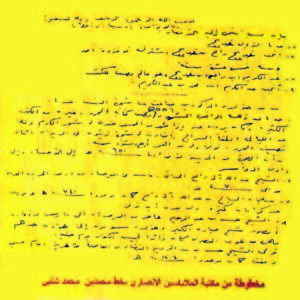
Explanation of the manuscript: In the name of God, the Most Gracious, the Most Merciful, and through it we seek refuge in us. Do not take us if we forget or make a mistake.
1 – Our first grandfather: Khadij Al Ansari.
2 – He gave birth to Khadij, Rafeh bin Khadij, may God be pleased with him, participated in the battle of Uhud and his age fifteen years.
3 – Abdul Karim Ibn Rafeh ([11]) Bin Khadij. It is a world classified for books
.4 – Abd al-Karim gave birth to his son, Muhammad ibn Abd al-Karim ….. After these mentioned, the family tree was lost
5 – We found Abu al-Qasim Abd al-Karim al-Rafi`i, famously 556 AH = (1161 CE), classified as the book of the editor, and many other books, and he was narrated from him, if he appeared from the mosque, he gave him the vineyard tree, and one night the lamp was extinguished, so an olive tree was lit in the Diwan. While classifying the editor, he died sixty-four years old. Immigration from Medina began to our ancestors around 650 AH = (1252 AD) to: Al-Ahsa and passing through Wadi Al-Dawasir
6 – Sheikh Abdullah Al-Rafie Al-Hasa’i ([12]), who lived in Al-Ahsa from the land of the Arabian Peninsula around the year 700 AH = (1300 AD).
7 – Suleiman al-Sayyah ibn Abdullah Al-Rafeh was present in 740 AH = (1339 AD), and he narrates many generations about him, and it is not known where he died.
8 – Sheikh Hassan bin Abdul Rahim emigrated from Al-Ahsa to Persia in the Emirate of Ansur, Sheikh Jabara Al-Kabir, and these are attributed to Hawazin, their grandfather Malik bin Auf Al-Nasri, who was commander of the infidels army on the day of Hanin. Mufti was present in the year 1204 AH = (1879 AD).
Al-Ansar lineage, Shafi’i school of thought, and Salafi faith.
We mention here Sheikh Ibrahim Ibn Sheikh Hassan ([13]) He read knowledge in Al-Ahsa four years, starting in the year 1330 AH, (1912 AD). And his lineage appeared with the Sheikhs of Al Mubarak who are now in Al-Ahsa.
1 – Abd al-Karim Ismail, a good man and merchant – Muhammad and Ibrahim gave birth to Ali and Ahmad, Ali, the curator of the mosque, and Ahmad, the muezzin of the Issa al-Othman mosque in Khaitan, and today the elite of those present is Ahmed. The last of this tree is Taha Yassin and his brothers, and Ismail Abd al-Karim and his brothers. Nakhudhah in merchant ships, and after the year 1390 AH, he became director of the Khaitan Cooperative Society.
It ended with the month of the two witnesses on the twenty-ninth of the account.
This poor lineage was written by God Almighty, Muhammad bin Muhammad bin Mahmoud bin Shalabi Al-Qahiri. On the eleventh of Jumada II, 1394 AH, the year one thousand three hundred and ninety four AH.
O Lord, draw me from everything from fire and your money, and we cannot see it
Correct the saying and delete everything saying Muslim and Bukhari as they said
They narrate from the prophet Al-Qurashi, the correct matter is what you see
Dear reader, I ask mercy to me, tell my God, this has escaped from Sakr
And invite the writer of such a reader, and whoever attends, if you find a defect, pay it off
Sealing systems with seas and palaces in the rooms, half a thousand thousand, oh no less
Rather pride is not a pride of chance. Whoever knows has learned and with a dream has worked
This saying is taken from the words of Sheikh Muhammad bin Abdul Rahim Al-Rafi ‘.
2 – Sheikh Abd al-Rahim bin Abdullah bin Abd al-Rahim 1214 AH (1799 CE), who is the younger brother of Sheikh Hassan bin Abdullah Ibn Abd al-Rahim, indicated that, as Mullah Abdullah bin Ibrahim al-Ansari pointed to his manuscript, the family of Rafeh.
Reading the first manuscript: (This manuscript was written, at the end of the book: Persuasion in Solving the Words of Abu Shujaa).
And the emptiness of writing this useful and honorable copy agreed, on the afternoon of Tuesday, eleven Rabi` Al-Awwal from 1214 AH, one thousand two hundred and fourteen AH (1799 A.D.), so it was not urgent with the narrow field, at the hands of the most despised servants, I ask God Almighty to protect his writer and owner: Abdul Rahim bin Abdullah bin Abdul Rahim bin Saeed bin Eid bin Ibrahim bin Suleiman al-Sayyah bin Abdullah, al-Shafi’i is a doctrine, and al-Rifa’i is impregnated, and the family of Rafeh al-Hasa’i is a relative ([14]). May God forgive him, his parents, what he loves, and his brothers. Amen.
The book was made and our Lord praises Him for gifts, generosity and generosity
After the prayers of the Prophet Muhammad, there was no smell, leaves and promises
Your friend’s anger reveals his conscience and lures of concealment of hidden secrets
The lute tells you about the inner secret, its smoke, and the fire
If one’s mind increases, it increases humility, and if one’s mind diminishes, it increases resistance
As a lamb of a branch, if it increases, it becomes more sloppy, and if that pregnancy becomes less, it becomes more preventive
The line in the Qartas looms forever and its writer is dirty in the dirt
The line stays alive after its author and the underground writer is buried
________________________________________
([1]) Kuwaiti researcher and historian, who has many books in history, heritage and media, holds the State Encouragement Prize in the field of historical studies and monuments, in the State of Kuwait, in the year 1429 AH = 2008 AD.
([2]) Sheikh Hammad Al-Ansari, may God have mercy on him, said: (The collection in the translation of Sheikh Hammad Al-Ansari 2/547) looked for the origin of people’s saying in this time about “Medina” and found that the first people to call it “the Medina” the Ottomans, and the companions The followers and those who after them many centuries say they are (the prophetic city).
([3]) This was favored by a group of scholars, historians, and translators, such as: “Ibn Al-Samani, Al-Ala’i, Jalaluddin Al-Qazwini, and he was chosen by Ibn Al-Malqan, Al-Zarkali in his book Al-Alam, and Ibn Hajar Al-Asqalani in liberating the suspect.”
([4]) This book contains a manuscript from it in the books of my grandfather Mulla Muhammad, written in 1093 AH, 1682 CE, which strengthens the inheritance of manuscripts and books on the authority of our grandfather.
([5]) We note the addition of (Al-Ahsai) to his name, because he inhabited Al-Ahsa for a long period of time, and he knew among its people this name, although it was originally affiliated to Rafi bin Khadeej Al-Ansari – as it was presented -.
([6]) At that time, most of the people in the eastern Arabian Gulf region were Arabs.
([7]) There are documents proving this talk dating back to that period.
([8]) Professor writer Khaled Salem bin Muhammad bin Abdullah Al-Ansari wrote in his handwriting a note in 1980 AD, confirming the existence of a tree for the family, but unfortunately it was lost, and the assets and branches were integrated, and his father saw him – may God have mercy on him – and was dealing with a period extending to The eighth century AH, in its library documents and manuscripts of dozens of our first grandparents, some dating back to the beginning of the thirteenth century AH. (Author).
([9]) And the continuation of the saying: (People are entrusted with their lineage, unless they claim honor): This saying is basically a doctrinal rule, and it is the ratification of lineage, and this saying does not mean believing someone who claims tribal lineage without proof, and if that were the lineage mixed, and expanded The suit.
([10]) See: The Fiqh of the Sunnah, by Sayyid Sabaq, Dar Al-Fateh for Arab Media, p. 21, 1420 AH – 199 CE, c 3, p. 228.
([11]) Companion Rafi bin Khadij, is the supreme father to which the scholar Sheikh Abdul Karim Al Rafii belongs, (he is Abdul Karim bin Abi Al Fadl bin Muhammad bin Abdul Karim bin Al Fadl bin Al Hassan bin Al Hussain Al Rafei Al Qazwini).
([12]) Mulla Yassin mentioned that our grandfather Al-Rafii was born around 556 (1161 AD), and migration to Al-Ahsa for our ancestors began around 650 AH (1252 AD), and Sheikh Abdullah Al-Rafi ‘was present around the year 700 AH (1301 AD), and the time interval is about one hundred to One hundred and forty years, or about five generations.
([13]) Sheikh Hassan, the supreme father, by Sheikh Ibrahim.
([14]) The family of Rafeh Al-Hasa’i: The family of Rafeh, relative to Rafeh bin Khadeej – may God be pleased with him – which is his supreme grandfather who is attributed to him, and Al-Hasa’i, relative to the soup; that is: Al-Ahsa, which is the place where he stayed after his emigration from Medina.
ــــــــــــــــــــــــــــــــــــــــــــــــــــــــــــــــــــــــــــــــــــــــــــــــــــــــــــــــــــــــــــــــــــــــــــــــــــــــــــــــــــــــــــــــــــــــــــــــــــــــــــــــــــــــــــــــــــــــــــــــــــــــــــــــــــــــــــــــــــــــــــــــــــــــــــــــ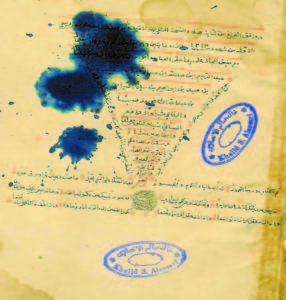
Read the manuscript
The book of Mulla Abdullah bin Ibrahim bin Abdullah bin Mubarak bin Saeed bin Abdul Rahim bin Sheikh Saeed bin Eid bin Suleiman bin Ibrahim bin Abdullah () Tourists, – God forgive him and his parents and Muslims and Muslims – Amen, O Lord of the worlds … old exchanged messages Confirmation of the family name and lineage of Al-Ansar: – Letter addressed to Mulla Yassin bin Ismail Al-Ansari, on the third of Rabi ‘1358 AH (1939AD) from Prince Ahmed Al-Khalaf, the Prince of Failaka in Kuwait at the time, and correspondence from one of the Emirs of Qatar, Sheikh Ali bin Jassim Al Thani, and Sheikh Abdul Rahman Mullah, one of the notables of Qatar, and Sheikh Salem Abdullah Ghanem, from the notables of Socotra in Yemen, and from the cousin of Mulla Yassin Haj Ibrahim Othman Al-Ansari in Amman, and a book from Sheikh Abdullah Al-Jaber Al-Sabah, Adviser to His Highness the Emir of the State of Kuwait, may God have mercy on him, and another letter from Zanzibar to Hajj Muhammad Shaheen Al-Ghanem – Agency with a legal instrument from a judge in Amman mentioned Mulla Yassin Al-Ansari – and a special power of attorney from Ibrahim Othman Al-Ansari To his brother Yusef Othman Al-Ansari in the year 1945 AD, – may God have mercy on them all – as he was known for his lineage, his title and his name among the people since ancient times with Mullah Yassin Al-Ansari .. And it is also known that our ancestors followed the same path that their ancestors followed and did not care about the titles, but their titles were Sheikh Muhammad Bin Abdul Rahim Al Ansari (Al-Rashed Al-Asaad), Sheikh Abdul Rahman bin Muhammad Abdul Rahim Al-Ansari (Abdul Rahman Al-Kabeer), Sheikh Khalid bin Salem bin Abdul Rahman Al-Ansari as a servant (true Sharia), and Sheikh Ibrahim bin Khalid bin Salem bin Abdul Rahman Al-Ansari (the dust of the scholars) Mulla Muhammad bin Abdullah Bin Ibrahim Al-Ansari (Servant of Sharia Al-Anwar). Clarification of the message: From Failaka on Rabi ’3, 1358 AH (1939). In the name of God, the Most Generous, Honorable Brother, Yassin Bin Ismail Al-Nassari (Al-Ansari), the distinguished, may God’s peace, mercy, and blessings be upon you. Always start your book …………………….
Old reciprocal letters attesting to the family’s surname and lineage:
– A letter addressed to Mulla Yassin bin Ismail Al-Ansari, on the third of Rabi’i in 1358 AH (1939AD) from Prince Ahmed Al-Khalaf, the Emir of Failaka in Kuwait at the time, and correspondence from one of the Emirs of Qatar, Sheikh Ali bin Jassim Al Thani, and Sheikh Abdul Rahman Al-Mulla, one of the notables of Qatar, From Sheikh Salem Abdullah Ghanem, from the notables of Socotra in Yemen, and from the cousin of Mulla Yassin Al-Haj Ibrahim Othman Al-Ansari in Amman, and a book from Sheikh Abdullah Al-Jaber Al-Sabah, adviser to His Highness the Emir of the State of Kuwait, may God have mercy on him, and another message from Zanzibar to Haj Muhammad Shaheen Al-Ghanim – A legal instrument agency from a judge in Amman mentioned Mullah Yassin Al-Ansari – a special power of attorney from Ibrahim Othman Al-Ansari to his brother Yusef Othman Al-Ansari in 1945 AD – may God have mercy on them all – as he was known for his lineage, his title and his name among the people since ancient times by Mullah Yassin Al-Ansari .. And it is also known that our ancestors followed the same path that their ancestors followed and did not care about the titles, but their surnames were Sheikh Muhammad bin Abdul Rahim Al-Ansari (Al-Rashid Al-Asaad), Sheikh Abdul Rahman bin Muhammad Abdul Rahim Al-Ansari (Abdul Rahman Al-Kabeer), Sheikh Khalid bin Salem bin Abdul Rahman Al-Ansari Khaddam (true Sharia), and Sheikh Ibrahim bin Khalid bin Salem bin Abdul Rahman Al-Ansari (dust) The people of knowledge) Mullah Muhammad bin Abdullah bin Ibrahim
Al-Ansari (Servant of Sharia Anwar).
Clarification of the message:
From Failaka on Rabi ‘3, 1358 AH (1939).
In the name of God
Honorable Honorable Brother Yassin bin Ismail Al-Nasari (Al-Ansari), the distinguished)
Peace, mercy and blessings of God. Always start your book …………………….
Correspondence with Mulla Yassin Al-Ansari from one of the Emirs of Qatar, Sheikh Ali bin Jassim Al Thani, and from Sheikh Abdul Rahman Al-Mulla in Qatar
4 – A letter addressed in 1365 AH 1946 CE, to Uncle Mullah Muhammad Ibn Abdullah Al-Ansari, as his lineage, fame and naming among people since ancient times was Al-Ansari and he is the grandfather of writer Khaled Salem Al-Ansari. Explanation of part of the manuscript: 24 Dhu Al-Qi’dah 1365 AH In the name of God the One to the presence of Janab Al-Mumdul Amjad Akram Al-Makram Al-Mulla Muhammed bin Abdullah Al-Ansari after peace and the mercy of God always … Sender: Mulla Issa bin Ahmed Its history is in the month of October 1950 A.D. 1369 AH, and it is formally and officially approved by the Emir of Kuwait at the time, and the British Consul, registered in the name of the owners Yassin and Abdul Karim Ismail Al Ansari, as well as the article (published in the Kuwaiti newspaper Al-Ray Al-Aam) buying (Bum Al-Hamidi) from Abdul Karim Abu Al-Malah in 1934 A.D. 1352 A.D. Kuwait Ruler of Kuwait Signature Name: Fath Al-Khair No. 1106 Owner’s name: Yassin and Abdel-Karim, sons of Ismail Al-Ansari. Date: 20 Dhu Al-Hijjah corresponding to 1369 AH corresponding to October 14, 1950 AD. This leave was given to the person called: Yasin, and Abdel-Karim, sons of Ismail Al-Ansari, for his professional profession of navigation, so please those who care The matter is to treat him according to the established traditions among the trading nations so that he does not hide. 6- A Kuwaiti passport issued in 1952 AD, 1371 AH, confirming the name of Mullah Yassin’s brother (Abdul Karim Ismail Al Ansari), that is, lineage and fame. 7 – Sheikh Abdullah Al-Rafei Al-Ahsai (Al-Hasai) (): the great-grandfather of the family, who migrated from Medina in the range of 650 AH = 1252 AD, to the Al-Ahsa region, and was added to his name Al-Ahsa’i, because he inhabited Al-Ahsa for a long period of time, and he was famous for this name and his lineage is related to my companions The Galilee, Rafeh bin Khadeej Al-Ansari – may God be pleased with him -, and he emigrated due to political instability, the weak economic resources that the region witnessed, in addition to the fierce tribal conflicts, and explained the resources that also reached the Al-Ahsa region in eastern Arabia, and Rafeh belongs to the great companion Rafeh bin Khadeej Al-Ansari – May Allah be pleased with him -.
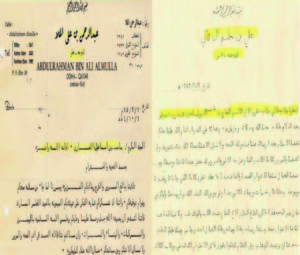

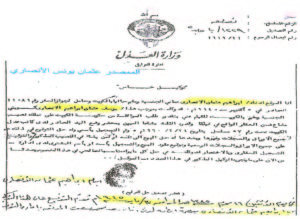
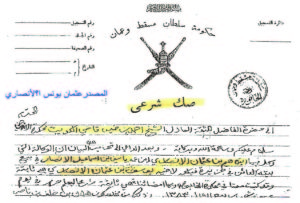
A message addressed in 1365 AH 1946 AD to Uncle Mullah Muhammad Ibn Abdullah Al-Ansari, as his lineage, fame and naming among people since ancient times was Al-Ansari and he is the grandfather of writer Khaled Salem Al-Ansari.
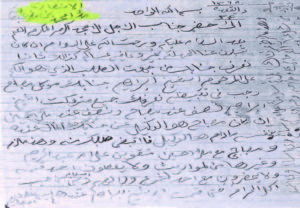
Clarification of part of the manuscript:
24 Dhu Al-Qi’dah 1365 AH in the name of the one God
To the glory of Janab-ul-Amjad, Akram Akram al-Alam, Mulla Muhammad bin Abdullah Al-Ansari
Always after the peace and mercy of God …
The sender: Mulla Issa bin Ahmed
An official possession letter registering (Boom Fateh Al-Khair), dated October 1950 A.D. 1369 AH, officially approved by the Emir of Kuwait at the time, and the British Consul, registered in the name of the owners Yassin and Abdul Karim Ismail Al-Ansari, as well as the article (published in the Kuwaiti newspaper Al-Rai Al-Aam) purchased Abdul Karim Abu Al-Salt in the year 1934 AD 1352 AH.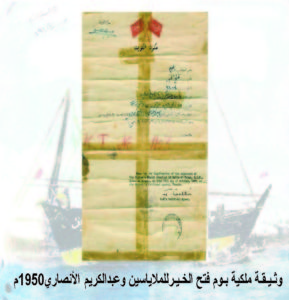
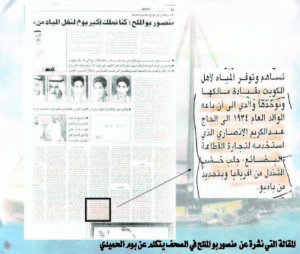
Clarification
Flag of Kuwait, ruler of Kuwait
Signature
Ship’s gender: Boom
Name: Fateh Al-Khair
Number: 1106
Owner’s name: Yassin and Abdel-Karim, sons of Ismail Al-Ansari.
Date: 20 Dhu al-Hijjah, corresponding to the year 1369 AH corresponding to October 14, 1950 AD This leave was given to the person called: Yassin, Abdul Karim, the sons of Ismail Al-Ansari for his professionalism in the navigation profession, so please those who are interested in treating him according to the established traditions among commercial nations so that he does not
hide
.
6- A Kuwaiti passport issued in 1952 AD, 1371 AH, confirming the name of Mullah Yassin’s brother (Abdul Karim Ismail Al Ansari), that is, lineage and fame.
Sheikh Abdullah Al-Rafie Al-Ahsai (Al-Hassai) ([1]):
The great-grandfather of the family, who immigrated from Medina in the range of 650 AH = 1252 AD, to the Al-Ahsa region, and was added to his name Al-Ahsa, because he inhabited Al-Ahsa for a long period of time, and he became famous with this name and his lineage is related to the great companions Rafi bin Khadeej Al-Ansari – may God be pleased with him -, and he migrated due to the lack of Political stability, and the weak economic resources that the region witnessed, in addition to the fierce tribal conflicts, and an explanation of the resources that also reached Al-Ahsa region in eastern Arabia, and Rafi ‘belongs to the great companion Rafi bin Khadeej Al-Ansari – may God be pleased with him -.
([1]) The family of Rafeh Al-Hasa’i: The family of Rafeh, relative to Rafeh bin Khadeej – may God be pleased with him – which is his supreme grandfather who is attributed to him, and Al-Hasa’i, relative to the soup; that is: Al-Ahsa, which is the place where he stayed after his emigration from Medina.
Professor Adib Khaled, quoting from his father, Mullah Salem al-Mulla Muhammad, mentioned in his manuscript the Al-Rafei family, i.e. confirmation of his lineage to Abdul Karim Al-Rafei.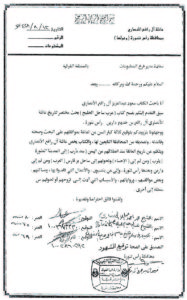
8 – A photocopy of a paper affixed by three senior family members, certified by Ras Tanura and around it, confirming our affiliation with the companions, Rafi bin Khadij Al Ansari – may God be pleased with him
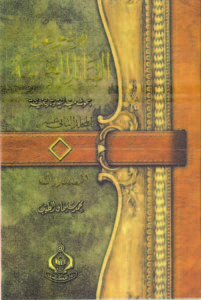 . 9 – A historical reference for the well-known Arab tribes: Pages of a historical book (Encyclopedia of Arab Tribes, Field and Historical Research – Twelfth Volume – Al-Mustarak) of the historical historian Muhammad Suleiman al-Tayyib, confirming that Sheikh Ibrahim’s grandfather lived in Failaka Island in 1335 AH. He came from Qatar and he is wealthy and wealthy, and he used to travel between the Gulf, Basra, India, Aden and Africa, according to the frequency and from certain sources from the elderly in the family and the people of Failaka that our grandfather Ibrahim, may God have mercy on him, arrived in Failaka from Qatar, studied religion, jurisprudence and forensic science, and disciples on his hands by memorizing the Qur’an The generous people of Failaka Island, among them Mulla Yusuf – may God have mercy on him – the pilgrim Janaa and the wealth of God and others
. 9 – A historical reference for the well-known Arab tribes: Pages of a historical book (Encyclopedia of Arab Tribes, Field and Historical Research – Twelfth Volume – Al-Mustarak) of the historical historian Muhammad Suleiman al-Tayyib, confirming that Sheikh Ibrahim’s grandfather lived in Failaka Island in 1335 AH. He came from Qatar and he is wealthy and wealthy, and he used to travel between the Gulf, Basra, India, Aden and Africa, according to the frequency and from certain sources from the elderly in the family and the people of Failaka that our grandfather Ibrahim, may God have mercy on him, arrived in Failaka from Qatar, studied religion, jurisprudence and forensic science, and disciples on his hands by memorizing the Qur’an The generous people of Failaka Island, among them Mulla Yusuf – may God have mercy on him – the pilgrim Janaa and the wealth of God and others

10 – A photocopy from the pages of a historical book (the history of the Ansar tribes in other countries and countries) for the historical historian Ansar, Dr. Yasser bin Humaid Al Abdul-Wahhab Al-Ansari, a resident of Makkah Al-Mukarramah – confirms the lineage of the family – of the Al-Rafeh and spread in three countries, which are the State of Kuwait and the Kingdom of Saudi Arabia and a country Qatar and have a close relationship …….. according to evidence and frequency.
2- The lineage column:
Mulla Yassin indicated in his documents: that Abdul Karim gave birth to his son Muhammad bin Abdul Karim, our grandfather, the famous Al-Rafii, 556 AH (1161 AD). And after these mentioned, the entire family tree of our descendants was lost from us. The professor Khalid Salim bin Muhammad bin Abdullah Al-Ansari wrote in his handwriting a note in 1980 AD about the existence of a family tree, but unfortunately it was lost, and the assets and branches were complete, and his father saw it – may God have mercy on him – And it covered a period extending to the eighth century AH, and in its library documents and manuscripts for dozens of our first grandparents, some of which date back to the beginning of the thirteenth century AH. It was passed down to it by inheritance, but it was not found by Professor Al-Adeeb, because it was lost with the lost papers and documents, After much effort and effort – may God reward him a thousand good – he was able to heal As many of these papers and documents were scattered between the pages of old books and manuscripts, and they were appropriately coordinated, which is inferred from the sequence of years of time, successive and varying from the history of this family, and in his library documents and manuscripts of ten of our first grandparents, the oldest of which dates back to the beginning of the third century As for the tenth of the Hijri year. As for the complete pedigree of the lineage, there is no, and I do not think that a lineage tree exists for all the families affiliated with the Arab tribes considered, it is sufficient frequency and fame, and the absence of appellant evidence, because the science of wound and amendment applies to pedigree, according to and attributed to, and the lineage and fame based on On the scroll scripts Yakh Abd al-Rahim Ibn Abdullah Ibn Abd al-Rahim al-Ansari, Mullah Muhammad bin Abd Allah, and the document of Mulla Yassin – may God have mercy on them all –
3- Frequency:
The frequency of trust and religion men quoting their fathers and grandfathers: A – Frequency of the grandparents: Mulla Ismail bin Ibrahim Al-Ansari, Mulla Hussein bin Ibrahim Al-Ansari, Mullah Muhammad bin Abdullah Al-Ansari, and Mulla Yassin, who are imams of mosques and judges. Al-Hajj Abdul Karim Al-Ansari, and Mulla Salem Mulla Muhammad al-Ansari – may God have mercy on them all – quoting their fathers and grandfathers, confirming their surname (Al-Ansar) and their lineage to Rabaa bin Khadij Al Ansari – may God be pleased with him – i.e. the famous and frequent transfer layer by layer in successive periods of time; the frequency of these men is trust and debt, according to Their parents and grandparents with their documents and th correspondence Shown by their dates from Mulla Yassin, Mullah Muhammad Abdullah Al-Ansari, Hajj Abdul Karim Al-Ansari, Hajj Abdullah Al-Mulla Hussein Al-Ansari, and Professor Adeeb Khalid Salem Al-Ansari. B – Confirmation of uncle’s children with mercy, Ras Tannour, Darain, and cousins and aunts in Qatar, quoting their parents and grandparents. Honor their affiliation, with their cousins in Kuwait, Saudi Arabia, and Qatar, for Al Ansari.
Live interviews with flags from the honorable family: mentioned in Chapter Two of this book. You can also hear them on the family’s website.
www. alansaris. Com
Click on the name to hear the interview
Press to hear the sound
1 – Al-Haj Ahmad Muhammad Ibrahim Al-Ansari.
2 – Click to hear the voice of Hajj Abdul Rahim Hussein Ibrahim Al Ansari.
3 – اLahj Youssef Ibrahim Ragab Al-Ansari.
Click here ysefibrhmMyMovie1
4 – Al-Haj Rashid Abdullah Khamis.
Click here rashedMyMovie
Haj Abdullah Hussein Ibrahim Al-Ansari.
Click here abdlahusn
6- An interview with Hajj Hussein Muhammad Yusuf Malalla (formerly Failaka Island Mukhtar).
Finally, the interview is with the writer, Khaled Salem Al-Ansari
Click here khldslm
The difference in proportions between ALANSAR, ALNOSOOR and ALMANASEER
First: Al-Ansar
Most of the adherents are j2 and some are j1, e -, and g
They are Qahtani, originally from Aws and Khazraj from Medina, which our family has the honor of belonging to them and whose lineage ends to the great companion Rafi bin Khadij Al-Awsi, may God be pleased with him. Their migration started from the village of Arwah, which is a mountain near the city, and they are the year of Shafi’i school of thought, and their journey from the city to various places was on the peninsula and the eastern coast, and they settled in Kuwait, Badarin, Saudi Arabia and Qatar until now ..
Second: Nusour
Most of them are on (J1c) L222 – and a few of them are on the M410 J2 and are made up of different tribes and families.
They are not a thigh, clan, or tribe, but an alliance of a group of authentic Arab Islamic tribes, some of whom are Jabal al-Khaldi, who migrated with Mansur bin Muqrin al-Jabri from the descendants of Muqrin bin Ajud bin Zamil al-Jabri, the ruler of Bahrain in the past, as it was under the control of Sheikh Jabara bin Yasser Al-Nassouri al-Jabri (1720 – 1773 AD) agreed Sheikh Jabbarah with others is not only from Jabour, the son of Khaled, but also with Kabir Bani Malik, Kabir Al Busfer, Kabir Al Marra, and Al Hammadi (Bani Hammad) from Qahtan and (the Obaidli) Abdallah Shammar and the Harami (Bani Haram) and from Al Ansar He swore the victory of the Nusra, and the other part denied any alliance with Nassour … Its fruit resulted in the conquest of Bahrain in the year 1724 AD, and when the Portuguese invaded Bahrain island and killed Muqrin al-Jabri, a branch of the Nusur Alliance, led by Prince Mansour al-Jabri, fled to Bur Persia, and after a time all the Mansouri alliance was called in relation to Prince Mansour al-Jabri, and after a time, the title was transferred from Al-Mansuri to Al-Nassouri One part attributes the same to Al-Mansoori and the other part is Al-Nasuri, and let us not say that all Saudis are from the same tribe of Al Saud, may God protect them. And Al-Nusour Al-Jabour from the Bani Khalid Sunnah of Hanbali sect belongs to the great companion Khalid Bin Al-Walid, may God be pleased with him from Khuzam from Quraysh and some of them mention their lineage to the Ameri tribes and T end to Hawazin Almdharah Adnaniyah God knows.
Third: The Manasir tribe
(J1c3d2) This sample is widespread in the Kabylie south
The Manaseer tribe is considered to be one of the Arab Al-Qahtani Al-Qudahiyah, whose lineage and origin dates back to Mansour bin Jamhur, where he was governor of Iraq in the year 126 AH. Most of its members moved from the north of the Arabian Peninsula to the east of its south for successive periods, passing through Al-Ahsa, Qatar and the Arab Emirates. These regions and they have influence in these countries to this day. They are among the large Bedouin tribes whose members are characterized by men of war and great despair as historians have described them. Therefore, we find that many families and individuals belonged to the Manasir tribe in a period not recently and they became an inseparable part of it or they were essentially since B. Any part of the tribe and then defected and then returned to it later, and so the case is found in the rest of the tribes in the peninsula. At the present time, the majority of the members of the tribe live in Abu Dhabi and the countries of the United Arab Emirates, and a good part has settled in the State of Qatar as well as the Kingdom of Saudi Arabia and the rest of the Arab Gulf State as there are some large families living in Yemen, as well as some families from the tribe settled in Persia And Iraq.
We divide the Manaseer tribe into 3 main branches:
The Boomnther The chieftain of this branch is located in the family of Al-Manea, including the late Sheikh Sultan bin Qaran, and Sheikh / Mubarak bin Qaran, who is the current Sheikh of the Boomnther branch.
The family of Burahmah, the sheikh of this branch is located in Al-Salmin and Al-Taib
The poetry of the sheikhdom of this branch is located in the Al-Zaytoun family, from the Al-Ghuenim family
These branches live with their thighs and families in close harmony and cohesion, and there has never been a significant dispute between these branches, and it is taken to the Manasir tribe that until now there is no single president (sheikh included).
__________________________________________
Oral sources, accounts of the elderly and documents remain an important source of descent, and thank God we have the accounts of our elderly people, and as pedigree scholars have said that piety, piety, confidence, know-how and knowledge of genealogy and history must be available in those who address the descent of the lineage .. they are documented sources, and as we mentioned on the site the names of men Who we went back to to verify the family lineage of Al-Ansari with proof on each page of the lineage of the source from which we took the news and the lineage.
In conclusion, we extend our sincere thanks and gratitude to the group, all the elderly and their young in: Kuwait, Saudi Arabia, Qatar, and God extended the age of those who stayed, and enriched the site by watching it, where they all affirm their affiliation with the supporters. Everyone from the people of religion, piety, knowledge, history, lineage and all the manuscripts and family documents attests that our doctrine is a year of preemption, which confirms our title of supporters, and therefore we are attributed to Rafi bin Khadij.
For example, who says I am among the Ansar, the proportion of his ancestors to a people are among the finest people after the prophets and they are the companions of the Ansar – and enough is enough for him -.
We inherited from our fathers, our fathers inherited from their fathers, and our grandfathers from their grandparents, from Kabir, we are from the Ansar, from the Aws, from the descendants of the great companion: Rafeh bin Khadij Al Ansari, and he goes without definition – may God be pleased with him – and history has recorded this for us And we will transfer to our children, and our grandchildren will transfer that generation after generation, until God inherits the land and those on it, and we will preserve that as we preserved those documents, God willing.
4- DNA testing of Haplogroup DNA and hereditary strains
Prove our lineage for Qahtan, Al-Azd and Al-Ansar (Prepared, collected and coordinated by Dr. Ahmed Abdel Karim Al-Ansari)
Almighty:) O people, said, I have created you from male and female and made you into nations and tribes so that the sight of God that God knows expert (13) ([closets: 13]. He said the Almighty: and your money or your children the way that Tqrbakm we Zolfa only Believe and do righteous deeds, for those of them have the reward of weakness for what they have done while they are in the rooms, they are safe (37) ﴾[Sabaah: 37, except that the knowledge of the human being has a title. To God’s prayers and peace be upon him: “Learn from your lineage what your wombs pray for, for the bond of the womb is love in the family, enriched in money, forgotten in the impact.” Narrator: Abu Hurairah. Genetics began in the mid-19th century, Gregor Mendel’s theory, the evolution of science, and a revolution of research until 1977 and 1983 until it reached the human genome in 2003. There are several companies that specialized in this field, the most important of which is the American TREE DNA FAMILY. FULLGENOMES and the Russian company YFULL by examining the male y chromosome inside the genetic genes inside the DNA. Imagine that one cell from your mouth identifies your human origin by matching two samples and knowing the interconnection between them (where the unknown ancestry sample is defined based on the matching of a known genealogical sample when it comes out as a result of a person He does not know his lineage, identical to a person with known lineage), because they are close to this age and that keeps you away from genealogical books and what most misfortune is misleading and misleading … except what has been proven about the Mustafa, peace and blessings be upon him, also allows this science to compare the results between the parties of the tribe dispersed in different places which Bearing Vs. name and find out common ancestor that lived among them how many years? But the person cannot know the tribe’s lineage or its origins, but only the type of the human race and determine the genetic mutations through the gathering of the largest number of types of strains and the genetic changes that are frequent, similar and close to each other. The results of the genetic fingerprint are almost definitive in proving the ratio of children to parents or exile them from them and it is not permissible to use Genetic footprint, with the intention of ensuring the validity of statutory lineages legally, except in cases identified by law for the possible occurrence of an error in the interpretation of genealogy results, which is possible as it applies to the results of other medical analyzes. Definitions and terms: The DNA is Adam, upon whom TB M: In Jewish and Christian beliefs (Genesis) and Islam is the first creature of human beings created by God and the creation of Eve from the left rib and put it in the ground, said the Almighty:) your Lord said to the angels, I will create a Khalifa in the earth ([Baqarah: 30]. And in the Qur’an we find his story of how soon God disobeyed her and God sent him to the earth to succeed him in it. He is called the Father of Mankind because the entire lineage of humanity is from his crucifixion. And it was called Adam because he was created from the earth’s land, i.e. dust. Anthropology (anthropology) which explores the origin of people, where he lived, the origins of strains, and how they started. DNA: is the genetic structure (relative to genes), i.e., the legacies that denote the identity of every individual. They are chemical symbols that bear the characteristics of the living organism, this fingerprint, symbolized by DNA, which is the genetic material found in the cells of all living organisms, it is a booklet that carries the characteristics and characteristics of every human being. Medical experiments have proven that every human being possesses hereditary traits that are unique to him and no one else can It is similar to others, such as fingerprints, and therefore the term genetic fingerprint of the Lala confirmed the identity of the person and the first person to discover the genetic genetics, the British scientist Jeffers in 1984, who identified some of the talismans of the genes that transmit the genetic ingredients from one generation to the next, and those ingredients contain all the genetic traits that a person carries. It includes each person, such as a fingerprint. How to transmit the genetic characteristics: the genetic traits are transmitted in a precise and accurate digital way through which scientists can perceive the relationship between the father and his children or deny them if it is not the expected results of examining the genetic fingerprint: ● Determine whether there is a relationship between a person N. ● Determine whether the two individuals are from a common ancestor. ● Detect whether there is a relationship between individuals who share a family name. ● Verify or deny the results of a specific lineage research. ● Identify a person’s racial features. (Genes) (genes) It is a very small piece that is not visible to the eye inside the cell nucleus. The gene is a long helical chain of DNA. Depending on the DNA sequence and the order of the nucleic acids in which the cell can read this code, it will produce the materials important for the proper functioning and function of the cell. SNP mutation and mutation is a change in the genetic information that is in the DNA. What is two or more DNA strings. It consists in changing the number, type, or arrangement of the nuclear particles that make up the DNA. Mutation: It is a mutation that occurred in an area of the genetic tapeSNP.This mutation is carried by the children of this person with whom it occurred. It is symbolized by a letter + numbers. For example, it comes after writing the strain, for example, JM70 L208 JL222.2. The mutation is constantly changing. HAPLOGROUP in Arabic means strain and refers to the total population that refer to one origin (ethnic groups and there are about twenty strains of A-T) and divided into several strains of factions and ethnic branches branched). Find the strain in the form of a letter in English, for example, J. TE, followed by the mutation J-M70 called Haplotype (where you will not find a pure basket today. According to genetics, it is Noah’s peace be upon him. F was born 90% of people who spread throughout the Earth..and many mutations occurred, which led to the change of the haplogroup The human being, each specific strain carries its own haplogroup that distinguishes it from others, for example Viking are distinguished by haplogroup I as well as the indigenous Europeans, they carry the haplogroup R and the Caucasus they carry the important G in the matter that each specific people have a special haplogroup that distinguishes it from other peoples and mixed many genetic strains. The strain through two tests: The first: Tests are conducted on the markers and are on several markers and starts from Y12-Y700 and enter the results on a calculator of a genetic predictor called ((PREDICTOR) Second: by examining a specific mutation (SNP), this mutation represents the grandfather that is presented by companies called the SNP PACK or a comprehensive examination. Each male chromosome is called (Y BIG), and it is mutated for nearly four generations. It is about 120 years old, so the J2 family writes and adds the name M172, meaning J2-M172.
This is a picture of the strains tree starting from Adam, peace be upon him, and we will find the strains in the letters that start alone starting from
A (Adam) A B C D E F G H I J K L M N O P Q R S T
It is arranged according to the English alphabet from our Islamic and Arabic history written in many books such as beginning and end and others,
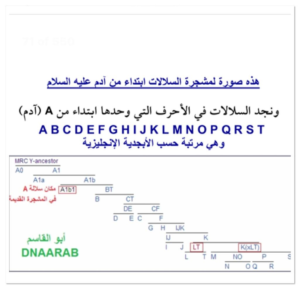
It says that the second human civilization that occurred after the flood and the stability of our master Noah in the circle of the fertile crescent. Mankind multiplied from the descendants of our master Noah, peace be upon him, then spread with divine power and instructing a king of angels, and humanity spread in every direction to the ancient Euphrates, and the spread of the sons of Shem and those who followed him from his nephews to South of the Arabian Peninsula, and from there they headed to the north, and these are some of their traces found in the south, north and east of the island. The Arabian Peninsula since that era includes a group of Semitic tribes and a few of his nephews. Where settlers who wanted to settle in. And the children of Noah, peace be upon him: He was born after he became 500 years old (2470 BC). The Almighty said:﴿ ﭑ ﭒ ﭓ ﭔ﴾ [As-Saffat: 77]. 1 – Sam (Abu al-Arab, Faris, the Children of Israel and the Romans). 2 – Ham (Abu Africa, Abyssinia, Sudan, and it is said: Copts are descendants of Qut ibn Ham). 3 – Japheth (Abu al-Turk, the Chinese, the people of Gog and Magog). 4 – (The fourth son who died an infidel drowned in the flood, differed in his name, some of them said: (Yam) and who said: (Canaan). Types of human strains in the results of DNA: 1 –
Strain A or A Haplogroup
It is divided into four sections (branches) and these branches are A1, A2, A3 and A * This star symbol (*) will always appear in all subsequent groups and its meaning is a group that does not have a custom mutation, and this ethnic group with its divisions is spread in East Africa, especially Ethiopia and Sudan and is found in proportions Few in West and South Africa and 1.1% in African Americans. The highest percentage is in Sudan, where it constitutes 42.5% of the Sudanese. 2- The dynasty
B or B Haplogroup
This group is divided into the following sections B *, B1 and B2 and both B1 and B2 in turn are divided into smaller and smaller groups, and they are also like the previous group A did not leave Africa, and also their number decreased in favor of the ethnic group E3a and the ethnic group B make up 2.3% of African Americans. 3 – strain C or
C Haplogroup
This ethnic group is divided into C *, C1, C2, C3, C4 and C5, where the descendants of C * are located in the Indian subcontinent, Sri Lanka and some parts of Southeast Asia, while C1, his descendants are located in Japan only, and C2 are located in New Guinea, Polynesia, and Melanesia (which is not Malaysia but rather Malaysia). A group of islands near Australia). As for C3, part of its descendants moved to the Americas after crossing the ice corridor formed between the two continents of Asia and America after they were in Central Asia, where the Mongols also descended from. The aboriginal ones, the last section C5, is B. Lille And They Are In India And Pakistan
. 4- Strain D Or D DHaplogroup
The components of the ethnic group D and its divisions are D *, D1, D2, and D3. The descendants of both sections D * and D3 were found in Central Asia. The descendants of D1 were in Central Asia, Mongolia, and South Asia, while the descendants of D2 were in Japan and were believed to be from the isolated groups In Japan for a period of 12 thousand years to 20 thousand years, they constitute 35% of the Japanese and 50% of the Tibetan people.
E or E – Haplogroup
Make up: Name up to the following sections E *, E1, E2, E3 and E4, all of which are except for E *, are divided into several sections, one part of this ethnic group which is E3b came out of Africa and another section that remained in it and spread widely in it and became one of the strongest strains of Africa, which is E3a, where it is located E * in Ethiopia and E1 and E2 in Northeast Africa, while E4 descended from it is a negligible number, the strong section of this group is E3 where this strain was formed in Northeast Africa, then one of its two sons, E3a, returned to the depth of Africa and became the dominant race It is where most of the African Americans are descended from this race. His brother E3b and this section descends from most of the Africans from North of Evil. S and northwestern Africa, and those who descend from this race are the ancient Egyptians and Berbers of the people of the Maghreb (the Berbers are actually the indigenous people of those areas they are in and their ancestors are 100% African) and a large percentage of Ethiopia and most Somali people belong to this race. Section E3b is from which E3b * and E3b1 are descended, and this last comes from five strains, the most widespread of which are three strains, the first is E3b1a carrying the M78 mutation and its descendants are the inhabitants of Northeast Africa from Egypt, Ethiopia and Somalia, and the second is E3b1b which is the barbaric strain specifically and carries the genetic mutation M81, so what A person carrying this mutation M81 is of Berber origins and a descendant of the E3b1b strain, the third strain is E3b1c and this strain is born in the Levant and constitutes a good percentage there, and the two African strains E3b1a and E3b1c were present in the Arabian Peninsula in deep times with the high strain, as these two have spread The two strains, in particular E3b 1a north to Europe and large proportions were formed in Albania, Macedonia, Greece, Serbia and Bosnia and the largest percentage is 35% in Albania, as it spread from the Balkans to the rest of the European countries, and here is a note that is not meaningful that the E3b family originated in Africa must bear certain specifications As if it is black or dark in color, do not forget that all human ethnic groups without exception came out of Africa, and all of this happened in ancient times, as the E3b family was estimated by the scientists to be (24) thousand years and the changes occur as we mentioned at any moment for any reason, the descendants of this faction E3b Whether in Morocco, the Levant, or Egypt and the Arabian Peninsula Colored the same physical composition of the different races in countries where the visitor
6. – strainG or G – Haplogroup
This group is divided into * G, G1, G2, G3, G4 and G5. It was formed in the area between the northern part of the Middle East and the regions of Pakistan and Afghanistan, and is called the Caucasian group, where 2% of the population of Western Europe and about (10-8) of the population of Spain come from. Italy, Greece, Turkey, 30% of the inhabitants of Asia and Azerbaijan, 50% of the population of North Ossetia, 18% of the Druze, 10% of Ashkenazi Jews and 20% of the Jews of Morocco. 7 – dynasty
R or R – Haplogroup
This ethnic group consists of sections * R, R1 and R2, and then divided into smaller strains where it is believed that the R1a strain formed in the northern Black Sea in Ursia, then went to eastern Europe and also south until it reached India, while the R1b strain was formed before the end of Ice Age, then spread to western Europe, where it is considered the first strain there, and reaches a percentage close to 100% in some areas of Ireland, and this strain is called the Atlantic Haplotype, and the R2 strain is found in South Asia, especially in India With little presence in Central Asia. 8 – strain
I or I – Haplogroup
This group consists of one section I1 where section I * did not notice and section I1 in turn consists of four sections which are I1 *, I1a, I1b and I1c, and this group I is considered a European group where it is not observed that there is outside Europe except for a few groups in the Middle East, and section I1a there Its largest proportions are in Scandinavia, Iceland and northwestern Europe, which is the Vikings, and there are numbers of them in the rest of Europe, while the I1b strain in addition to northwest Europe is also present in the Balkans and Sardinia. Section I1c has been discovered again and is present in Germany and the Netherlands.
9 – StrainH or H – Haplogroup
This group consists of * H, H1 and H2, where H1 is in turn divided into sections, and it is believed that it was born in the Indian subcontinent, as it is 35% in the lower classes in India of the Dravidian origins, and 4% in Pashtun and 4% of it descend Iranians and 12.5% of the Tajiks, while in Europe the Roma people of India are the origin of the presence of this strain in Europe.
10 – the strainL or L – Haplogroup
: This strain was born more than 30 thousand years ago in South Asia (India), and is found in a few degrees in central Asia and Europe, and in the Arab region is concentrated in the Levant countries as a result of ancient migration, and it may be the Roma who are the reason for spreading this strain in the places where they were , Divided into L *, L1, L2, L3.
11 – StrainM or M – Haplogroup
The components of the ethnic group (M), which consists of the sections M *, M1 and M2, this group is found in New Guinea and makes up about a third of the population there. 12 – Strain N or N N- Haplogroup:
The constituent sections of this group, namely N *, N1, N2, and N3, may have originated in North Asia, such as northern China and Mongolia, and then spread to the Baltic republics, Siberia, and Northern Europe, where the N3 strain has spread among Finns, and the N1 strain is found in Kazakhstan, China, and Korea, and finally N * It is found in Cambodia.
13 – strainO or O – Haplogroup
: It is believed that the origin of this group is East Asia and it consists of the following sections O *, O1, O2 and O3 as the largest family is O3 which is the dominant family in China while O1 and O2 are found in Southeast Asia in the countries of Malaysia, Vietnam, Indonesia and southern China, and in Japan and Korea there is the strain O2b is largely there and it is descending from O2.
14 – strainK or K – Haplogroup
The constituent divisions of this ethnic group are K *, K1, K2, K3, K4, K5, K6, K7, L, M, NO, P, and the last four sections are separate ethnic groups due to their expansion, and the ethnic K group is located in Central South Asia (Iran) and descends from it and from its lineage most of the population of the northern hemisphere The floor is defined by mutation number M9 and its sections spread as follows, K1 is spread in Solomon Islands (SOLOMON ISLANDS) and Fiji Islands as for K2 in Somalia, Ethiopia and North Africa (Egypt) and Southwest Asia and among the celebrities belonging to this family K2 President Thomas Jefferson is a rare ethnic among Europeans, and this is why the president has a story mentioned in the viewer’s chapter The people who have known their strains, K5 is the main strain of the population of Papua New Guinea (Papua New Guinea), where it constitutes 50% of the population there and in a few percentages in Indonesia and Melanesia (which is not Malaysia) while the rest of the strains are very few and are found in Eurasia, Africa, South Pacific, Australia and Melanesia Section K5 was recently renamed and S named as a separate group. Section K2 and T were also renamed as a separate group.
Q or Q – Haplogroup
The place of birth in Central Asia is divided into the following sections Q *, Q1, Q2, Q3, Q4, Q5 and Q6 which is one of the two groups that crossed to the American continents and that crossed during the ice age on the frozen path that was between the two continents, and the strains that make up it are, Q1 which is present in China In the Hazara minority in Afghanistan in small proportions, the Q2 strain is present in the middle of Siberia in medium proportions, while the Q3 is the strain that crossed into America and the Indians in North and South America descend from it, and the Q5 section was found in a small percentage in the Jews of Yemen and section Q6 was found in simple proportions in India and Pakistan .
16 – The BreedS or S – Haplogroup
This strain is descended from the large strain K and was formerly called K5 and is the largest proportion in New Guinea and also in Indonesia and Melanesia and is not Malaysia.
17 – Strain T or T – Haplogroup
: This strain is descended from the large strain K and was previously called K2 and it was born in Asia what is now Iran and spread horizontally from this region until it reached Egypt and also entered
Haplogroup
grandson of the man J2. This strain has spread since the ancient times in Central Asia and Iran to India as it reached this The strain to Europe, during the same periods and stages that the E3b strain reached Europe. The J2 strain is composed of Muslim Kurds, Iraqis, Lebanese, and Arabs in the Arabian Peninsula, from the Georgians (the former Soviet Republic of Georgia), from Turkmenistan, from Ashkenazi Jews, from Sephardic Jews, and from Iranians. There are also in different regions of Europe in varying proportions not exceeding 7%. As for India, the two strains (J2b2, J2a) are two strains of J2 that reached India in very ancient times with the tribes that entered India and led to the displacement of the indigenous people belonging to ethnic H , C, D. Note that India is one of the most ethnically mixed regions of Turkey and Iran, where most of the ethnicities in the world are located in India. 19 – J1 strain or J1 – Haplogroup: The age of this strain is not less than 10 thousand years, and the origin of this strain in the south of the fertile crescent, which is southern Iraq And there were two strong migrations, the first occurred ten thousand years ago (10 thousand) years ago and headed towards Europe, Yemen and Ethiopia, and its entry to Abyssinia may be through Yemen, as this strain is nott is located north of Abyssinia until we say that it entered from the north, and then Yemen became after thousands of years from the centers exporting ethnicity J1, and from it the opposite migrations of the Chaldeans and Babylonians came out around 3000 BC and others to Iraq and the Levant and other places, then after this spread the second emigration took place through displacement The strong Islamic Arab and what distinguishes this strain upon examination is the presence of the genetic mutation M267. If you carry it, you are the grandson of the man J1. And we’ll talk about it in detail. What has been revealed so far from the results of those who examined from the Arab tribes that they are of one origin they called the symbol (J) and this old gene symbolizes the ancient Semitic tribes (including Arab Jews) until a genetic mutation occurred or what is called a mutation, which is a change in the genetic information In terms of quantity, quality, and number, which occurs approximately every 210 years, which is called rapid change SNP such as the marker (DYS439) or occurs once every 4545 years, and it is called slow change STR as the marker (DYS388), so they divided the result of this mutation into two strains: the strain ( J1) and the strain (J2). The supposed J1 dynasty in the Jewish priests can easily be found at the present time in the Arab specimens it held 9,000 years ago, and there is nothing to indicate the Jewish priesthood in it. The Arab mutation (P58 J1c3) is spreading to Yemen, most of the Arabian Peninsula, Africa, and others. The highest percentages recorded globally: recorded in the geography of the Arab countries (Yemen + Saudi Arabia + Iraq + Palestine + Khartoum in Sudan) all recorded rates exceeding 70 percent. + Likewise (there are “old mutations” different branches of the changes spread among the Arabs). Branches = 84% of the Dagestan tribes of Dargins, Lezgins, Avars in the North Caucasus (and to a small degree not exceeding 5 to 10 percent in Anatolia – Turkey – Iran and Europe) and in the field of human genetics, Haplogroup J is one of the most widespread patriarchal strains in the Arab world And the Middle East, it is believed that the geographical origin of this J strain is the mutation of J1 and J2 mutation in the Caucasus near Chechnya, how many It is said that he was born and even found for the first time in the Al-Hilal Al-Saib region, i.e. Iraq, the Levant and Anatolia, and knew a wide spread in the Mediterranean basin, Europe and India, especially in the time period that followed the Great Agricultural Revolution in the Fertile Crescent and Mesopotamia, demographic changes occurred during the Neolithic or Neolithic period, then People migrated to the north, south, east, and west, and some to the Caucasus countries were the ones who headed north, some to the countries of Anatolia, and they headed south to the Arabian Peninsula thousands of years ago, and there are Arabs in the era of the Semitic peoples. There are migrations towards Chechnya and the Caspian Sea in a recent era to spread the Islamic call, as confirmed by Dr. Ibrahim Al-Jureishi, expert of genetic sites, and Professor Ibrahim Al-Salian, supervisor of transformation M67, may God reward them with a thousand good for their advice and giving their generous opinion as a guiding light to us. (North of Mecca). And we start from the place of its spread is the Bahrain region, which extends from the coast of Oman in the south to Iraq in the north. It is noticed that most of the Arabs of J2 are from the following branches: On the percentage of 88% registered in the Ingush nationality and Chechens and in the state of Azerbaijan (all of them are eastern Caucasus) as it has Eurasian (Anatolian Plateau + Caucasus + Iran) + the Levant coasts especially Lebanon + North Central Iraq + the eastern coasts of Saudi Arabia + Sardinia, Italy and a slight representation in North Africa (the Tunisian city of “Masaken” almost all samples belong to J2) and the rest of the Arab countries. We find the branch of the J2 or J-M172 strain: this strain is believed to have originated between the southern Caucasus and northern Mesopotamia and carries a genetic mutation M172 and is estimated The dynasty is 30,000 years old. The men of the J2 strain have settled in most of eastern Anatolia, southern Caucasus, and S. Iran tended from 12 thousand years ago and it seems they were nomadic hunters and collectors of fruits and then herders of livestock as well. They spread south to Iraq and the eastern coasts of Saudi Arabia, Yemen and north to the Levant and western Anatolia and from there to southeastern Europe and also some of them went to Central Asia and India. We find the branch J2b * -M12 on which samples from Qatar and Iraq came out, then the branch J2b1-M205 branched out and this branch is overshadowed by the Omani results and it is an immigrant to Oman from the area between Qatar and Iraq and from Oman has spread. Then the branch J2b2-M241 and this is spread in the Bahrain region And we find and north of the island, Iraq and the Levant. Then the branch J2a2-M410> L581 and this branch is overshadowed by the results from the territory of Bahrain, including the spread and reached Yemen, the Levant, Egypt and Libya. At the top of this mutation there are samples from Iraq and Lebanon.
Dr. Ahmad Al-Ansari J2 a1a1a1b1 as a result of analyzes of the strain d. Ahmed Abdul-Karim Al-Ansari and his supporters are mostly identical to the Qahtan family as follows
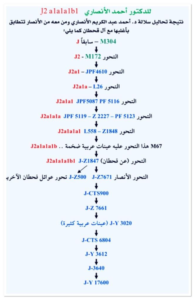
: M304 – Previously J Mutation
J2 – M172 mutation J2a1 –
JPF4610 mutation
J2a1a – L26 mutation
J2a1a1 JPF5087 PF 5116 mutation
J2a1a1a JPF 5119 – Z 2227 – PF 5123 mutation
J2a1a1a1 L558 – Z1848 M67
This mutation has huge Arab samples .. J2a1a1a1b mutation (from Qahtan)
J2a1a1a1b1 J-Z1847 mutation supporters
J-Z500
J-Z7671 mutation of other Qahtan families
J-CTS900
J-Z 7661 J-Y 3020
(Many Arabic Samples) J-CTS 6804
J-Y 3612
J-3640
J-Y 17600
The fairy lineage of Ansari is identical to the Qahtan tribe, including the families of Afaliq, Akleb, Rabia, Al-Maain, Abdul Qais, as well as the Ubaidah, the Bassam family, the Saqr family, and others from J2 to the mutant Z1847J2a1a1a1b1 — M172-10> PF4610> L26> PF5116> PF5123 Z67> Z27 -F5132 / Z500> M92> Z504> FGC20253 + CTS2906 / CTS4132 / FGC20250> S19243 Source: FAMILYTREE DNA: J2 ARABTRIBE 7/21/2019. We would like to note that websites are being developed by increasing the results of DNA analyzes, and we take this opportunity to present many Thanks and gratitude to the distinguished distinguished webmaster, Mr. Abdul Majeed Al-Tuwaijri. He was distinguished by his supervision of many sites, and we benefited a lot from him by revising and organizing this topic. May God reward him. A thousand good. Source 🙂 – J2-Middle East Project Arab – Y-DNA, Project J2 strain in the Arab world: JM172) Al-Afaliq resided in a thigh from Qahdar from Qahtan in Al-Buwayn from the suburbs of Unayzah, then in the experts, and in Al-Ahsa among them: Sheikh Ahmed bin Hassan bin Rashid bin Afaleq (1254 AH). Among them: Al-Skeet, Al-Mayouf, Al-Suhaibani, Al-Sagheer, Al-Saddlan and others. From the Ayyaf family from Khatham, from Qahtan. He followed them from the family of Afalek, the people of soup, from Aklib, Aarshia. is over.
Source: Skilled lineages of civilized families in Najd, more and revised edition Written by: Hamad Al-Jasser Page: 551 –
Alansar-AZD-Sabaa) Al-Ansar – Al-Azd – Sheba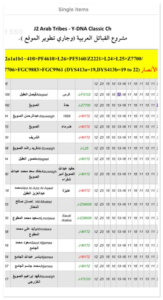
(Famlytree DNA Arab-Sabaa_Tribes – Y-DNA Source
A project is underway and the site is being developed with an increase in the results of analyzes. 254689
Al-Ansari J-M172500637 (Yamama.P J-BY112574M6765
Al-Mawajdah J-FGC42781M8126 Al-Ansari Al-Ansari J-Y17406188772
Azed – Ansar supporters
J-M172181110 Azed – Ansar supporters of J-M172255000
ALmotawa Saeed Muhammad Al-Mutawa
J-M172259516 Saud Aljamea Saud Muhammad Al-Jami
J-M172259517 Alsuwaigh Fahd Ibrahim Al-Suwaigh Al-Khazraji
J-F3133193313 Azed – Khazraj – Iraq Al-Khazraj
J-M172 193309 Azed – Khazraj – Iraq J-BY9476193305 Azed – Khazraj
– Iraq J-BY9476193376 Azed – Ansar – Iraq J-ZS10558418838 Al-Ghalabi Al-Khazraji Andalusia
(Arab T studies) E-M35 193295 Azed – Ansar – Iraq J-BY9473
Al-Qahtaniyah and Adeniyah Arabs showed 90% of them on the J line) and 10% on the E line and other changes. Where the changes in the results of the honorable Ansar appeared on E-J1-J2- and E -M123 and G and a sample of Professor Murtada Al Nafeh-Enfa-Al-Ansari appeared on E-BY214154 () and E1b1b1c1a and its distinctive presence in Azad Oman and its extension along the coast line Arabian from the Arabian Peninsula), and there are supporters on R1, T, and other dynasties that have Arabic branches.
Qahtan tribe
The lineage of the Qahtan tribe: the saying was divided into the lineage of Qahtan into several sayings: 1- From the descendants of Ismail Qahtan bin Hamisaa bin Teman, and in it it was named Yemen bin Nabit bin Ismail bin Ibrahim, peace be upon them. 2- He attributed it to Qahtan bin Hood bin Abdullah bin wind bin leather Aad bin Aus bin Aram bin Sam bin Noah, peace be upon him. 3- They mentioned that Qahtan and Quttan are brothers, they are the sons of Eber bin Shalakh bin Arfakhdhs bin Sam bin Noah, peace be upon him. 4- It was also said: Qahtan, he is Qahtan bin Abir, and in Abir he meets Al-Lahyan Qahtan And Adnan. To this, Al-Qudai points out in his poem: To the transient who threw metallic and well-known, and transient is the Prophet Hood, peace be upon him bin Shalakh bin Arfakhshad Bensam bin Noah «peace be upon him» Ibn Mukmim bin Mutlashh bin Akhnoukh bin Yaliel bin Mahalail bin Qainan bin Anoush Ibn Sheth bin Adam «upon him Peace”. Imam Al-Hafez, the famous Hadith of Taj al-Din Abu Saad Abd al-Karim bin Muhammad bin Mansour al-Samani al-Tamimi al-Marwazi, mentioned al-Samani as attributed to Samaan (the belly of Tamim). A traveling historian from Hafiz Hadith. He was born in 506 AH, and he died in 562 AH. He went to the far reaches of the country, and met scholars and speakers, and took from them, he said, may God have mercy on him: This lineage to Qahtan, in Yemen .. He said, and he is the one who belongs to all the supporters, and all of Yemen, and they are the sons of Arab bin Yashjab bin Qahtan, and his name Yaktan bin Amer bin Shalakh Bin Arfahshad bin Sam bin Noah, peace be upon him. * Qahtan’s attribution to the Prophet of God is incorrect. Imam Ibn Hazm said in writing the genealogy of the genealogy of the Arabs: Qahtan from the son of Sam bin Noah; and God knows best; and it was said: From the son of Hood, peace be upon him, and this is also invalid by the certainty of God Almighty’s saying:﴿ To the habit of their brother Hood ۗ﴾ [Hood: 50], and the Almighty said As for what they used to do, they perished with a strong wind, a roaring cockroach, and as he returned, they perished with a strong wind, which was mocked at them for seven nights and eight days, and the people saw in them a struggle as if they were empty palm trees, so what is it? And Hud, peace be upon him, who returned, and you do not see the rest of Adad .. Ibn al-Kalbi said: People say that Hudah Abir ibn Arfakhdhs is a false statement because Hud ibn Abdullah ibn al-Jaladah ibn Awad ibn Aram bin Sam bin Noah, peace be upon him. Wahb bin Munabh al-San’ani was asked about al-Yamaniah, “Is their father?”: Hood, and he said: No, but “temptations” occurred among the Arabs, and proud of “harmful to her father” Ismail, so Yemen claimed a hood to have a “father” of the prophets. There is no disagreement that Qahtan and the two brothers, Qahtan Abu al-Yemen and the Abu Sham, exaggerated. The owner of the promoter said: “The correct aspect of the lineage of Qahtan is that it is Qahtan bin Abir bin Shalakh bin Arfakhshad bin Sam bin Noah.” This is the higher lineage of Qahtan, which is the companion for him, a male among the lineage. Al-Qalqashandi said: As for Qahtan, according to some of the scholars, he is the son of them Ya`sa bin Yaman bin Nabat bin Qidra bin Ismail, peace be upon him. . Qahtan is one of the oldest Arab tribes, and among the most conservative are the ancient Arab returns, whose number is very large and they are the origin of the Arabs and their homes are between Najran, Asir, and southern Najd, and the Trinity. He is the first of the kings of Yemen, also called the Arab Arabs, and the Qahtan tribe is one of the indigenous Arab tribes, who lived in the south and central Arabian Peninsula moving from one side to the other, in search of fertile pastures for their livestock. The nomenclature of this tribe has changed from the oldest ancestor to the closest ancestor, and Qahtan is a different character in it and in its true existence, and Qahtan is said to be the grandfather of the Sabaean Arabs, based on the arrival of the name ‘Yaktan’ in the distorted Torah as known to Muslims, and depending on the appearance of a stone inscription meaning Qahtan. Note that the inscriptions appeared by other names, including: (Azad, Kinda .. and others). This confirms that the residents of southern Arabia did not attribute themselves to one man named “Qahtan”, but “Qahtan” was the name of a village or a tribe at the time that was not left It has a neighborhood today. And because if the Sabeans were to attribute themselves to the grandfather of his name (Qahtan) at that time, the name (Azd) and (Kinda) would not be mentioned, for example, and they are descendants of their great-grandfather, Sheba. The current Qahtan tribes are attributed to the ancient “Mudhahj” tribe, which lived in Yemen and migrated from it after the collapse of the Ma’rib Dam. And Mudhajj bin Malik bin Kahlan bin Saba bin Ishjab bin Yarub bin Qahtan and it was said: All Arabs are related to Ismael bin Ibrahim, peace be upon them both. The Qahtan tribes are not purely Adenian, and that Adnan is an Arabized tribe that came from the north as Ismail, peace be upon him. As for Qahtan, it is from the Sami donkeys and their origins are Yemeni. The well-known and correct is that the Arab Arabs before Ismail, and the Arab Arabs among them: Aad, Thamud, Tasm, Gadis, Amim, Jarir, Amalek, and other nations that only God knows were before Hebron, peace be upon him, and also in his time. As for the Arabized Arabs: they are the Arabs of Hijaz It is the offspring of Ismail bin Ibrahim, peace be upon them. As for the Arabs of Yemen: they are donkeys, the famous being that they are from Qahtan, and his name: Defeated, said by Ibn Makula. Which means that their lineage could not fall within the Adanite, Ishaqi, and Ghassanid dynasties. Some scholars mentioned that they were four brothers: Qahtan, Qaht, Mahhtah, Faleh, Qahtan bin Hood, and it was said: It is Hudh. Qahtan tribes include: (Al-Habab tribe) (Al-Jahdir tribe) (tribes of Al-Sirri and Sharif) (tribes of his servants) (tribe of Sanhan) (tribes of Rafidah) (tribes of Bani Bishr). As for the supporters (Al-Aws and Al-Khazraj), they are the sons of Thaalba bin Mazen bin Al-Azad bin Malik bin Kahlan bin Saba bin bin Ashgab bin Arab bin Qahtan.
The ratios of Alous and AlKhazraj
Al-Aws and Al-Khazraj are two of the tribes of Mazen bin Al-Azd (Ghassan), the Kahalani-Qahtaniya. They migrated during the collapse of Nebula, to settle in Yathrib, or what is known today as the Prophet’s city in Hijaz next to Al-Khazraj. Today they are called Al-Ansar, and they are two brothers: ● Al-Aws are Al-Aws bin Haritha bin Thaalbah bin Amr bin Amer bin Haritha bin Thaalbah bin Mazen bin Al-Azd (Ghassan) bin Al-Ghouth bin Nebt bin Malik bin Zaid bin Kahlan bin Saba bin Yashgab bin Yaar Ibn Qahtan. ● Al-Khazraj They are the sons of Khazraj bin Haritha bin Thaalbah bin Amr bin Amer bin Harir Eh Bin Thalabah Bin Mazen Bin Al Azd (Ghassan) Bin Al Ghouth Bin Nebt Bin Malik Bin Zaid Bin Kahlan Bin Saba Bin Ashgab Bin Yarob Ibn Qahtan. ● They are called the Banu Qila in proportion to their mother, which is: Qila bint Al Arqam bin Amr bin Jafna bin Amr bin Amer Bin Ma’a Al-Sama Bin Harithah Bin Ummer Al-Qais Bin Thaalba Bin Mazen Bin Al-Azd, and it was said: Qila Bint Kahil Bin Adhara Bin Saad Hadhim Bin Zaid Bin Laith Bin Soud Bin Aslam Bin Elhaf Bin Qada’a.
● myOrigins MapAhmad Abd Al-Karem Al-Ansari Al Ansari
Middle Eastern 83% Central / South Asian 15% otsY-DNA SNP J2 Arab Tribes – Y-DNA Classic Ch The Arab Tribes Project (site under development). F3133> Z7706> FGC9883> FGC9961 (DYS413a = 19, DYS413b = 19 to 22)
MODE 12 23 15 10 13-16 11 15 11 13 11 30534 N115459 Alaqeel Faisal Al Aqeel Al Rass
J-F3133 12 23 15 10 12-16 11 15 11 13 11 30535 B219092 Al Shawaij Jeddah
J-Z7700 12 23 15 10 13-16 11 15 11 13 11 29536 M6884 Alsuwaigh Abdul Rahman Al-Suwayegh 1959
J-M172 12 23 15 10 13-16 11 15 11 13 11 30537 418770 Al-Shawaij Darma
J-M172 12 23 15 10 13-16 11 15 11 13 11 30538 423200 Al Sharif
J-M172 12 23 15 10 13-16 11 15 11 13 11 30539 223498 Al-Suwaigh Farid Rashid Al-Swaygh
J-L25 12 23 15 10 13-16 11 15 11 13 11 30540 M8964 Alageel Mansour Al-Aqil
J-M172 12 23 15 10 13-16 11 15 11 13 11 30541 293490
J-M172 12 23 15 10 13-16 11 15 11 13 11 30542 M10016 Abd Al-Aziz Al-Aqeel Muhammad Abdulaziz Al-Aqil Unayzah
J-M172 12 23 15 10 13-16 11 15 11 13 11 30543 284883 Al-Moataz d. Ihsan Saleh Al-Mu’taz
J-Z39009 12 23 15 10 13-16 11 15 11 13 11 30544 255000 ALmotawa Saeed Muhammad Al Mutawa
Saudi Arabia J-Z39009 12 23 15 10 13-16 11 15 11 13 11 30545 270438
J-M172 12 23 15 10 13-16 11 15 11 13 11 30546 259516 Saud Aljamea Saud Muhammad Al-Jami
J-M172 12 23 15 10 13-16 11 15 11 13 11 30547 255154 Aljamea Yasser Abdullah Al-JameaJ-M172 12 23 15 10 13-16 11 15 11 13 11 30548 270437 Aljamea Muhammad Jassem Al Jamea
J-M172 12 23 15 10 13-16 11 15 11 13 11 30549 259517 Alsuwaigh Fahd Ibrahim Al-Suwaigh Al-Khazraji
J-F3133 12 23 15 10 13-16 11 15 11 13 11 30 Al-Azd project in Family Tree
FAMILYTREE AZAD-Y-DNA The site is being developed and arranged with an increase in the results of the analyzes. ZZZ.
J2 MIN 12 23 14 10 13-14 11 14 11 12 10 28MAX
13 25 16 11 14-19 11 16 12 14 11 30MODE 12 23 14 10 13-16 11 15 11 13 11 30M11937
. J-SK1382 12 23 14 10 13-14 11 16 12 13 11 30
M8126 Al-Ansari ALANSARI J-Y17406
12 23 14 10 13-16 11 15 11 13 11 30B219092 Al-Suwaij Jeddah
J-Z7700 12 23 15 10 13-16 11 15 11 13 11 29 M12882.
J-M172 12 24 14 11 13-15 11 14 12 14 11 302 425 754 nan
Al J-M205 12 24 16 10 14-19 11 15 11 12 10 28394564 Shaalan Al-Ahsa
J-M172 13 25 15 10 13-17 11 15 11 13 11 29
3-J2a4b (AZAD-Y-DNA Classi CharA ZAD ALANSARFAMILYTREE
M6765 located – Jordan Jordan J1 12 22 14 12 13-19 11 17 11 13 11 29
M8126 Al-Ansari Kuwait J2 12 23 14 10 13-16 11 15 11 13 11181110
Azed – Ansar Saudi Arabia
J2 12 23 14 10 15-20 11 16 12 13 11188772
Azed – Ansar Saudi Arabia
J2 12 23 14 10 15-20 11 16 12 13 11165857
Zedan Egypt J1c3d 12 23 15 10 13-14 11 16 11 14 11193313
Azed – Khazraj – Iraq Iraq J2 12 25 14 11 13-16 11 16 11 14 12193309
Azed – Khazraj – Iraq Iraq J1c3d2 13 23 14 11 13-18 11 17 11 13 11 Sheba-Kahlan-Mazen-Al-Ansar
Saba-Qahlan-Azed – Mazin – Ansar ● 188772 Azed – Ansar Saudi Arabia
Al-Ansar: The Descendants of the Companion Os Ibn Khawli Al-Khazraji – Mazen – Al-Azd, The Villages of Wadi Fatimah Makkah Al-Mukarramah
* * * *M6812 Aubdalkreem Nassar Al Ayoubi Saudi Arabia J1 12 24 14 11 12-19 11 17 12 14 11 31 * * * * * * * * * * * * * * * * * * * * * * * * * * *193313 Azed – Khazraj – Iraq Iraq J2 12 25 14 11 13-16 11 16 11 14 12 31 * * * * * * * * * * * * * * * * * * * * * * * * * 246938 Alansari Unknown Origin J2 13 23 14 10 12-14 11 13 11 13 11 29 17 9-9 11 11 19 15 20 28 13-16-17-17 10 10 20-21 14 14 17 15 31-34 13 9
193309 Azed – Khazraj – Iraq Iraq J1c3d213 23 14 11 13-18 11 17 11 13 11 30 * * * * *

Y FULL yfull Company
A Russian company called yfull, such as the Family Tree Company, which is one of the strongest authorities involved in studying samples. It does a global wooded work and raises the sample on their site and studies the sample for you, and they add it with the samples close to you and determine the age that separates the samples, and in determining the age of the common ancestor .. First When the subscriber adds the BAM file to the Yfull Timberland, it is placed near the close match for the sample below the positive mutation, and new branches are added when more samples are added. In general, we notice the first number formed: indicates the age of the origin of the mutation in years. And it was possible to calculate the common ancestor in years, the second number, which is TMRCA, the most recent common ancestor, i.e. the genealogies meet and collect according to the number of samples, and it is symbolized by TMRCA, which is the abbreviation of Ancestor The Most Recent Common, which is the newest individual to which the members of the group descend. Calculation of ages, and there are many examples and evidence. Note the result of Y FULL in the image shown here by Dr. Ahmed Al-Ansari and in the arrow in black script. (Kingdom of Saudi Arabia, Madinah)) The sample number is ID DRALANSARI YF 09741 and is positive for mutation from J-Y17600 * and differs from the lower samples which are negative mutation which is 2500–4000 years from Chechnya, Russia, Georgia and others. The website is being developed and arranged to increase the results of the analyzes. Ahmed Abdul Karim Al-Ansari id: YF09741SAU [SA-03] In the field of human genetics, Haplogroup J is one of the most widespread parental connotations in the Arab world and the Middle East, and it is believed that the geographical origin of this strain J is a mutation of J1 and J2 in the Caucasus near Chechnya And, as it is said that he was born and even found for the first time in the Fertile Crescent region, i.e. Iraq, the Levant and Anatolia, and knew a wide spread in the Mediterranean basin, Europe and India, especially in the time period that followed the Great Agricultural Revolution in the Fertile Crescent and Mesopotamia, demographic changes occurred during the Neolithic or Neolithic era Then people took Migrate to the north, south, east and west, and some to the Caucasus countries are those who headed north, and some to Anatolia, and they headed south to the Arabian Peninsula thousands of years ago, and there are Arabs in the era of the Semitic peoples. There are migrations towards Chechnya and the Caspian Sea in a recent era to spread the Islamic call, as confirmed by Dr. Ibrahim Al-Jureishi, Genetic Site Trainer and MR Ibrahim Al-Suleian Supervisor of Mutation M67 mutation J-17600 * JY17406 is positive-transformation [IN Y FULL], and there are several positive Arab mutations and Chechen negative mutations as shown in the results of YF.
J-17600 * JY17406 Positive mutation [IN YFULL], and there are several positive Arab mutations and Chechen negative mutations as indicated by the results of WYF. Purified
